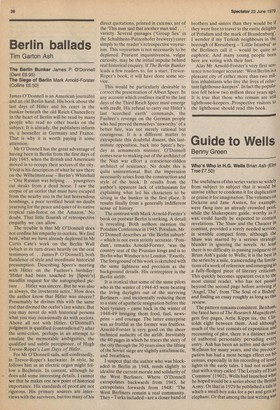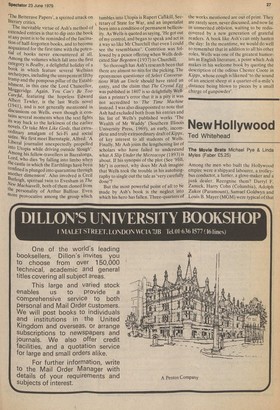Guide to Wells
Benny Green
Who's Who In H.G. Wells Brian Ash (E1l11 Tree £7.50) The usefulness of this series varies so widely from subject to subject that it would be unwise either to condemn it for duplication or praise it for imagination. The volumes on Dickens and Jane Austen, for example, were flung into an already crowded pool, while the Shakespeare guide, worthy asit was, could hardly be expected to contain revelations. The Shaw and the Chaucer in contrast, provided a sorely needed service, in sensible compact form, although the Shaw was marred by a serious strategic blunder in ignoring the novels. At least there is no difficulty in passing judgment on Brian Ash's guide to Wells; it is the best 10 the series by a mile, transcending the limitations of a work of reference and emerging as a fully-fledged piece of literary criticisra. This quickly becomes apparent even to the most casual reader, who has not passed beyond the second page before arriving at, 'Angel, The', from 'The Soul of a Bishop and finding an essay roughly as long as this review.
The pattern remains consistent. Benhattl, the fated hero of The Research Magnificent, gets five pages, Artie Kipps six, the Clis' solds eight between them. And although much of the text consists of exposition and recounting of plot, there is a distinct sense of authorial personality pervading everY entry. Ash has been an active and devoted Wellsian for many years, and the preoccur pation has had a most benign effect on hls census, especially in his recording of lesser lights in the early tales. I had not realised that with a story called 'The Loyalty of Esau Common' (1902), Wells had launched what he hoped would be a series about the British Army. Or that in 1929 he published a taleill which a small boy asks for a pet and gets ail elephant. Or that among the last writing Os 'The Betterave Papers', a spirited attack on literary critics.
The inevitable virtue of Ash's method of extended entries is that to dip into the book at any point is to be reminded of the fascination of half-forgotten books, and to become acquainted for the first time with the potential of books never encountered at all. Among the volumes which fall into the first category is Bealby, a delightful holiday of a book in which feature several Wellsian archetypes, including the unrepentent filthy tramp and the pompous pillar of the Establishment, in this case the Lord Chancellor, Moggeridge. Again, You Can't Be Too Careful, featuring the hopeless Edward Albert Tewler, is the last Wells novel (1941), and is not generally mentioned in discussions on Wells, even though it contains several moments when the text fights its way back to the larkiness of the earlier novels. Or take Men Like Gods, that extraordinary amalgam of Sci-Fi and social satire. We first meet Barnstaple, Alfred: 'A Liberal journalist unexpectedly propelled into Utopia while driving outside Slough'. Among his fellow-travellers in Barralonga, Lord, who dies 'by falling into limbo when the castle in which the Earthlings have been confined is plunged into quarantine through another dimension'. Also involved is Cecil Burleigh, spiritual twin to Evesham in The Nev Machiavelli, both of them cloned from the personality of Arthur Balfour. Even more provocative among the group which tumbles into Utopia is Rupert Carskill, Sec )1, retary of State for War, and an imperialist born into a condition of permanent bellicosity. As Wells is quoted as saying, 'He got out of my control, and began to speak and act in a way so like Mr Churchill that even I could see the resemblance'. Contrition was followed by a peace offering when Wells dedicated Star Begotten (1937) to Churchill. So thorough has Ash's research been that there are almost no nits for the picking. The eponymous questioner of Select Conversations With an Uncle should have rated an entry, and the claim that The Crystal Egg was published in 1807 is so delightfully Wellsian a printer's error that it is a pity it was not accredited to The Time Machine instead. I was also disappointed to note that Ash had excluded both from his entries and his list of Wells's published works 'The Wealth of Mr Waddy' (Southern Illinois University Press, 1969), an early, incomplete and truly extraordinary draft of Kipps, of key interest to all students of Wells. Finally, Mr Ash joins the lengthening list of scholars who have failed to understand what A Slip Under the Microscope (1893) is about. If his synopsis of the plot (See 'Hill, Mr') is correct, why does Mr Ash imagine that Wells took the trouble in his autobiography to single out the tale as 'very carefully done'?
But the most powerful point of all to be made by Ash's book is the neglect into which his hero has fallen. Three-quarters of the works mentioned are out of print. They are rarely seen, never discussed, and now lie in unmerited oblivion, waiting to be rediscovered by a new generation of grateful readers. A book like Ash's can only hasten the day: In the meantime, we would do well to remember that in addition to all his other roles, Wells was one of the greatest humorists in English literature, a point which Ash makes in his welcome book by quoting the description of the odious Chester Coote in Kipps, whose cough is likened 'to the sound of an ancient sheep at a quarter-of-a-mile's distance being blown to pieces by a small charge of gunpowder'.











































 Previous page
Previous page